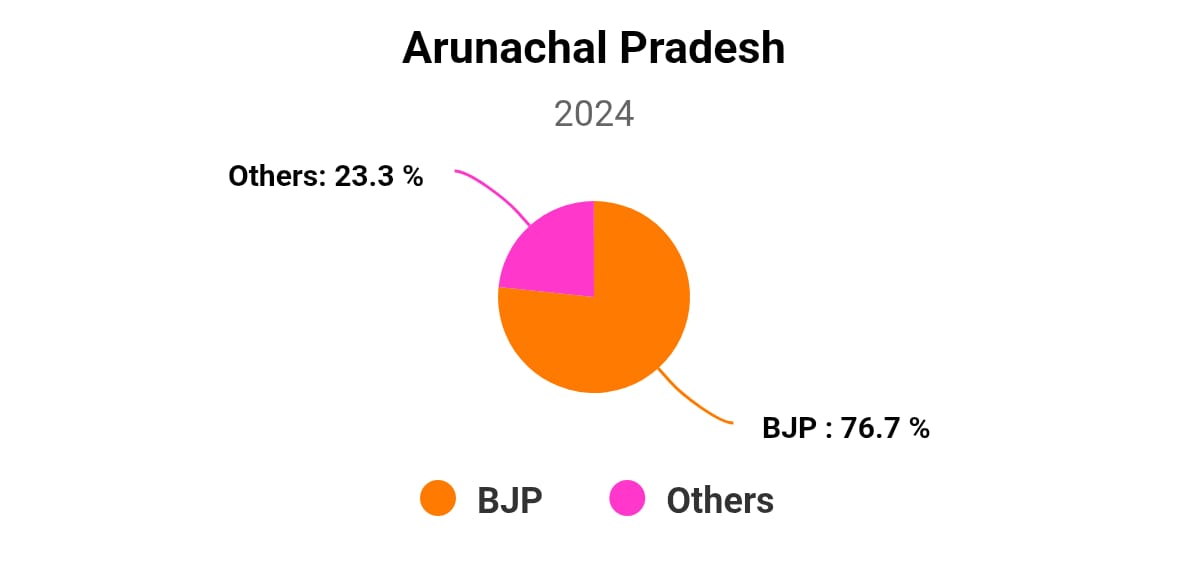Arunachal Pradesh Assembly Election
1978 Arunachal Pradesh Legislative Assembly Election Results
| 1978 Arunachal Pradesh Legislative Assembly Election Results | |||
|---|---|---|---|
| Sr. No. | Short Name | Full Name | Seats |
| 1 | JNP | Janata Party | 17 |
| 2 | PPA | People's Party of Arunachal | 8 |
| 3 | INC | Indian National Congress | 1 |
| 4 | Independents & Others | Independents & Others | 4 |
| Total | 30 | ||
The 1978 Arunachal Pradesh Legislative Assembly election was the first general election held in the state after its formation. The election was conducted in February 1978, with 30 constituencies, including two reserved for Scheduled Tribes. A total of 86 candidates from various political parties contested the election .

1980 Arunachal Pradesh Legislative Assembly Election Results
| 1980 Arunachal Pradesh Legislative Assembly Election Results | |||
|---|---|---|---|
| Sr. No. | Short Name | Full Name | Seats |
| 1 | INC(I) | Indian National Congress (Indira) | 13 |
| 2 | PPA | People's Party of Arunachal | 13 |
| 3 | Independents & Others | Independents & Others | 4 |
| Total | 30 | ||
The 1980 Arunachal Pradesh Legislative Assembly election was held on January 3, 1980, with 30 constituencies up for election. A total of 95 candidates contested the election. The Indian National Congress (Indira) and the People's Party of Arunachal (PPA) each won 13 seats, while independents secured the remaining 4 seats. This election marked the formation of a coalition government between the Indian National Congress and independents, with Gegong Apang becoming the Chief Minister.
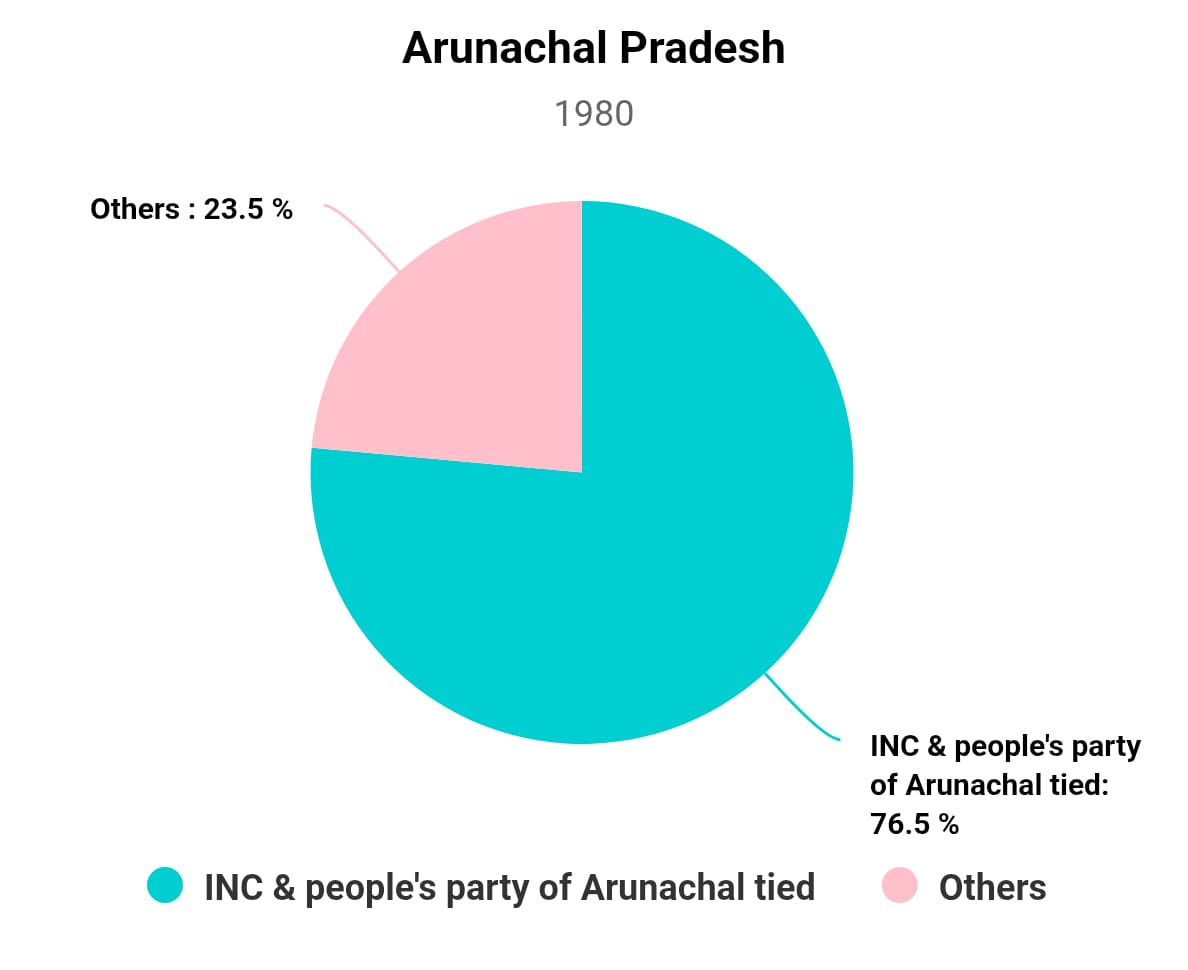
1984 Arunachal Pradesh Legislative Assembly Election Results
| 1984 Arunachal Pradesh Legislative Assembly Election Results | |||
|---|---|---|---|
| Sr. No. | Short Name | Full Name | Seats |
| 1 | INC | Indian National Congress | 21 |
| 2 | PPA | People's Party of Arunachal | 4 |
| 3 | Independents & Others | Independents & Others | 5 |
| Total | 30 | ||
The 1984 Arunachal Pradesh Legislative Assembly election was held in December 1984, marking the third general election to the state's legislative assembly. The Indian National Congress (INC) achieved a significant victory, securing 21 out of the 30 seats, thereby forming the government. Gegong Apang continued as the Chief Minister, a position he had held since 1980.
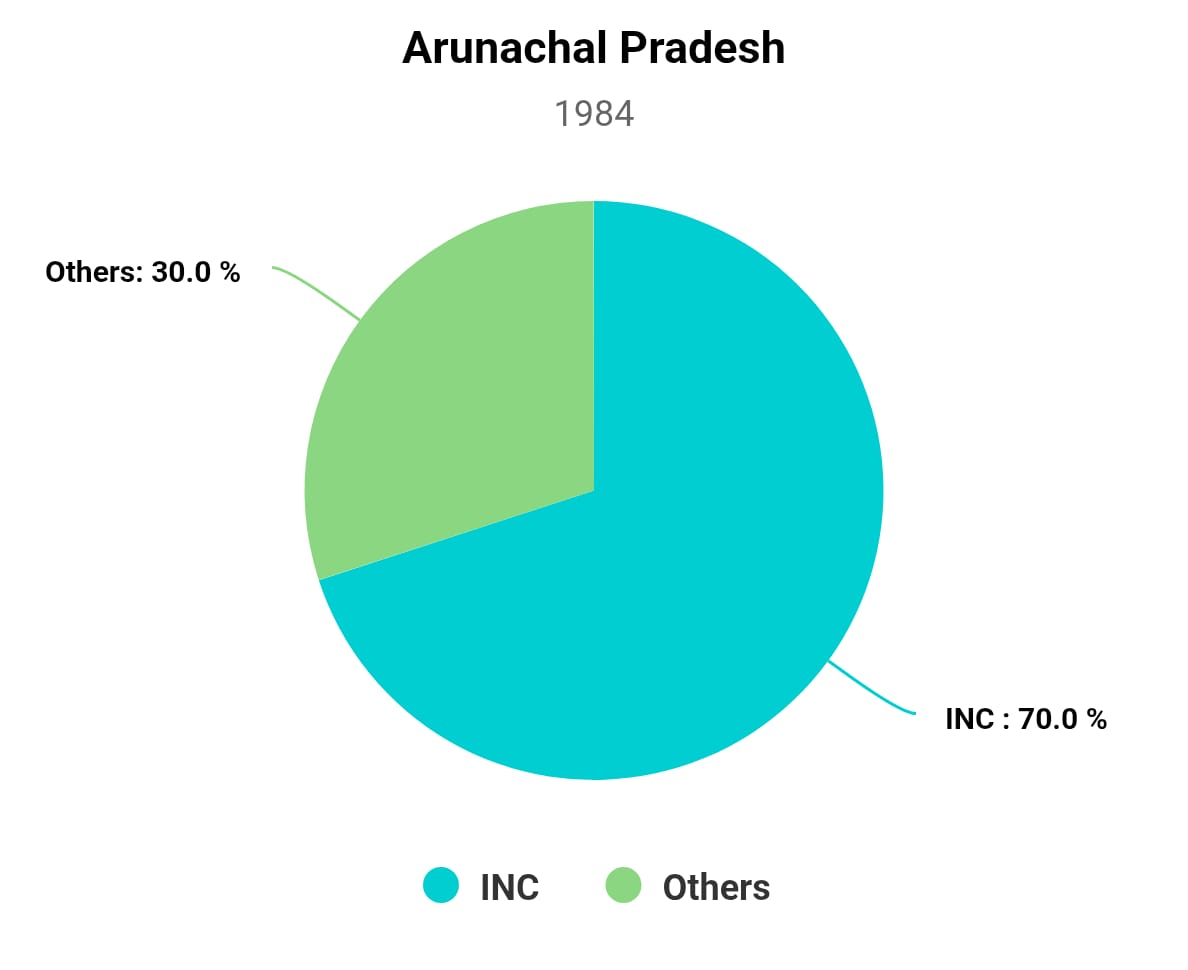
1990 Arunachal Pradesh Legislative Assembly Election Results
| 1990 Arunachal Pradesh Legislative Assembly Election Results | |||
|---|---|---|---|
| Sr. No. | Short Name | Full Name | Seats |
| 1 | INC | Indian National Congress | 37 |
| 2 | JD | Janta Party | 11 |
| 3 | JP | Janta Party | 1 |
| 4 | Independents & Others | Independents & Others | 11 |
| Total | 60 | ||
The 1990 Arunachal Pradesh Legislative Assembly election was the fourth general election held in the state. It was conducted in February 1990, following the implementation of the Arunachal Pradesh Act of 1986, which granted the state full legislative powers. The election was held for all 60 constituencies, with 59 reserved for Scheduled Tribes and 1 for the General category. A total of 170 candidates contested the election. The Indian National Congress (INC) emerged as the largest party, winning 37 seats. The Janata Dal (JD) secured 11 seats, while 11 independent candidates were also elected. The voter turnout was approximately 69.7%, with 356,289 votes cast out of 511,154 eligible electors.
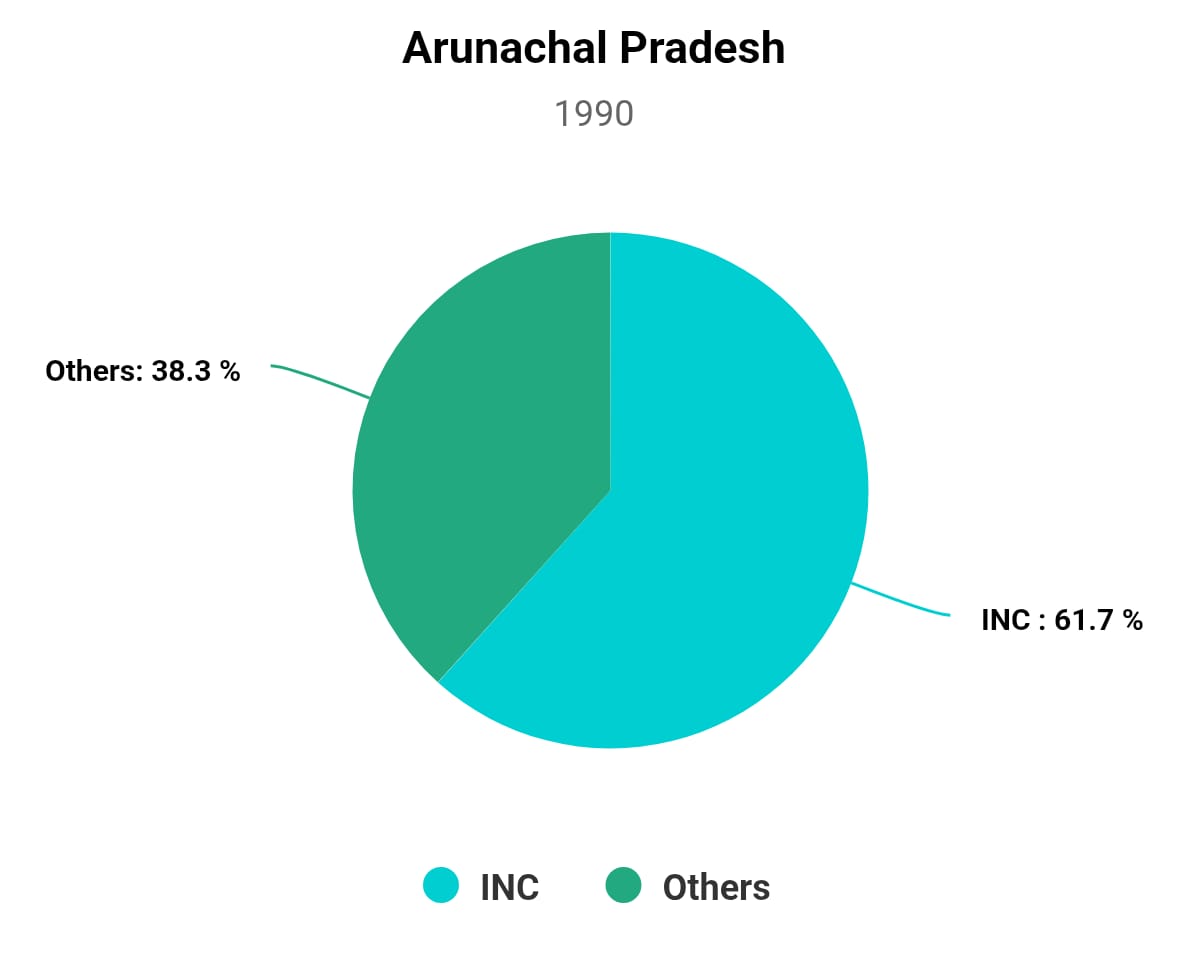
1995 Arunachal Pradesh Legislative Assembly Election
| 1995 Arunachal Pradesh Legislative Assembly Election | |||
|---|---|---|---|
| Sr. No. | Short Name | Full Name | Seats |
| 1 | INC | Indian National Congress | 43 |
| 2 | IND | Independents | 12 |
| 3 | Other | Other | 5 |
| Total | 60 | ||
The 5th Legislative Assembly election in Arunachal Pradesh was held in 1995, for all 60 assembly seats.
Indian National Congress (INC), led by Gegong Apang, won a clear majority with 43 seats, retaining power with Apang continuing as Chief Minister.
The Janata Dal (JD) could only win 3 seats, a significant decline compared to previous performance.
The Janata Party (JP) captured 2 seats, while Independent (IND) candidates won 12 seats, highlighting a considerable presence of non-party-affiliated MLAs.
The election was notably held across 1,728 polling stations, with an average of 309 electors per station
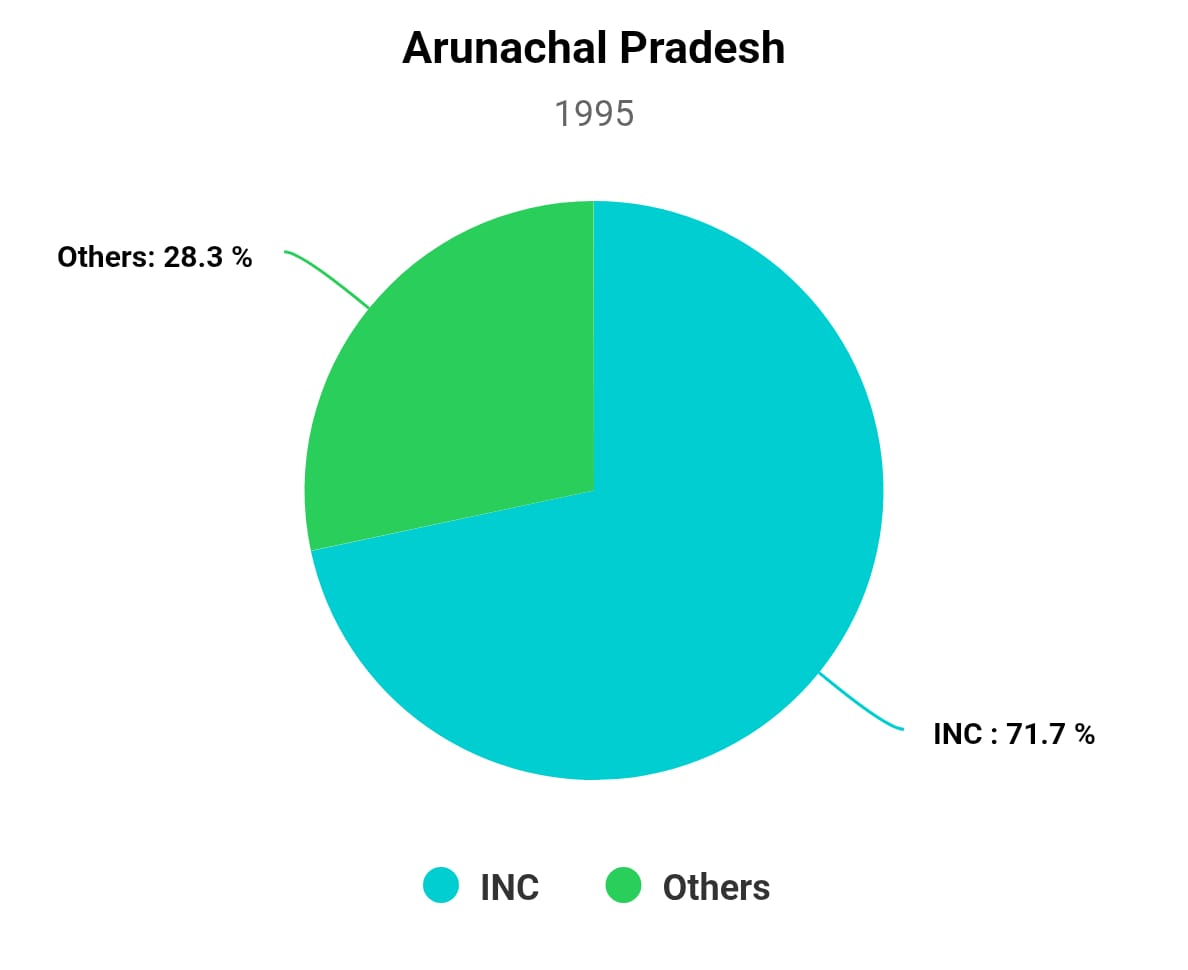
1999 Arunachal Pradesh Legislative Assembly Election
| 1999 Arunachal Pradesh Legislative Assembly Election | |||
|---|---|---|---|
| Sr. No. | Short Name | Full Name | Seats |
| 1 | INC | Indian National Congress | 53 |
| 2 | NCP | Nationalist Congress Party | 4 |
| 3 | Independents & Others | Independents & Others | 3 |
| Total | 60 | ||
The INC’s dominant win with 53 seats indicated continuity in governance and shift in leadership from Apang to Mukut Mithi.
The emergence of NCP as a meaningful political force with 4 seats underscored diversification of political representation.
The presence of Arunachal Congress and independents—though modest in seat count—reflects a dynamic local political landscape.
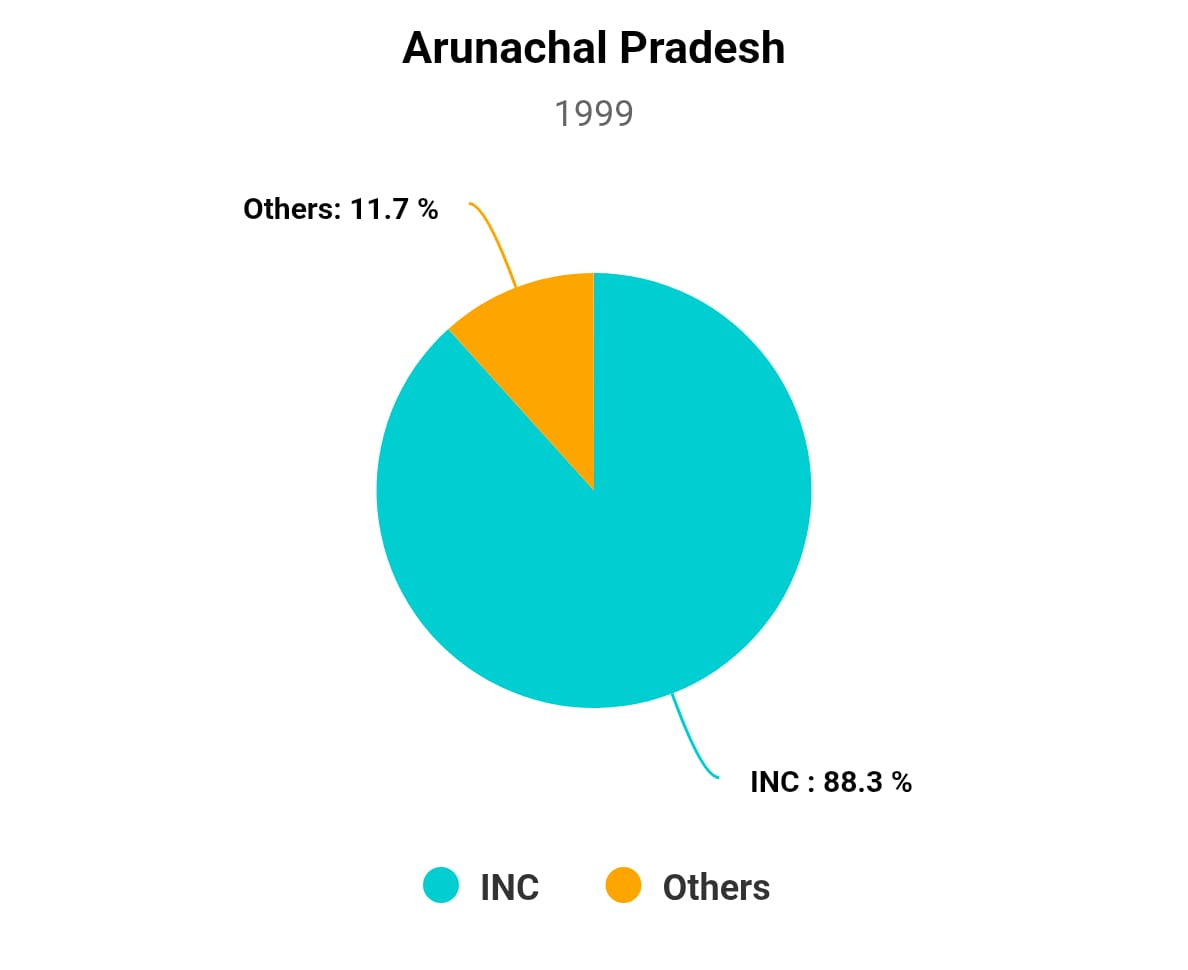
2004 Arunachal Pradesh Legislative Assembly Election
| 2004 Arunachal Pradesh Legislative Assembly Election | |||
|---|---|---|---|
| Sr. No. | Short Name | Full Name | Seats |
| 1 | INC | Indian National Congress | 34 |
| 2 | IND | Independents | 13 |
| 3 | BJP | Bharatiya Janata Party | 9 |
| 4 | Other | Other | 4 |
| Total | 60 | ||
INC Maintained Dominance: With 34 seats, Congress retained a clear majority, and Apang continued as the Chief Minister.
Independent Influence: Thirteen independents won seats, demonstrating the local, non-partisan nature of regional politics.
BJP's Emerging Role: Secured nine seats — a notable breakthrough that hinted at the party's growing foothold in the state.
Smaller Parties: NCP and AC held minor but visible roles with two seats each, showing fragmented party politics beyond the two main players.
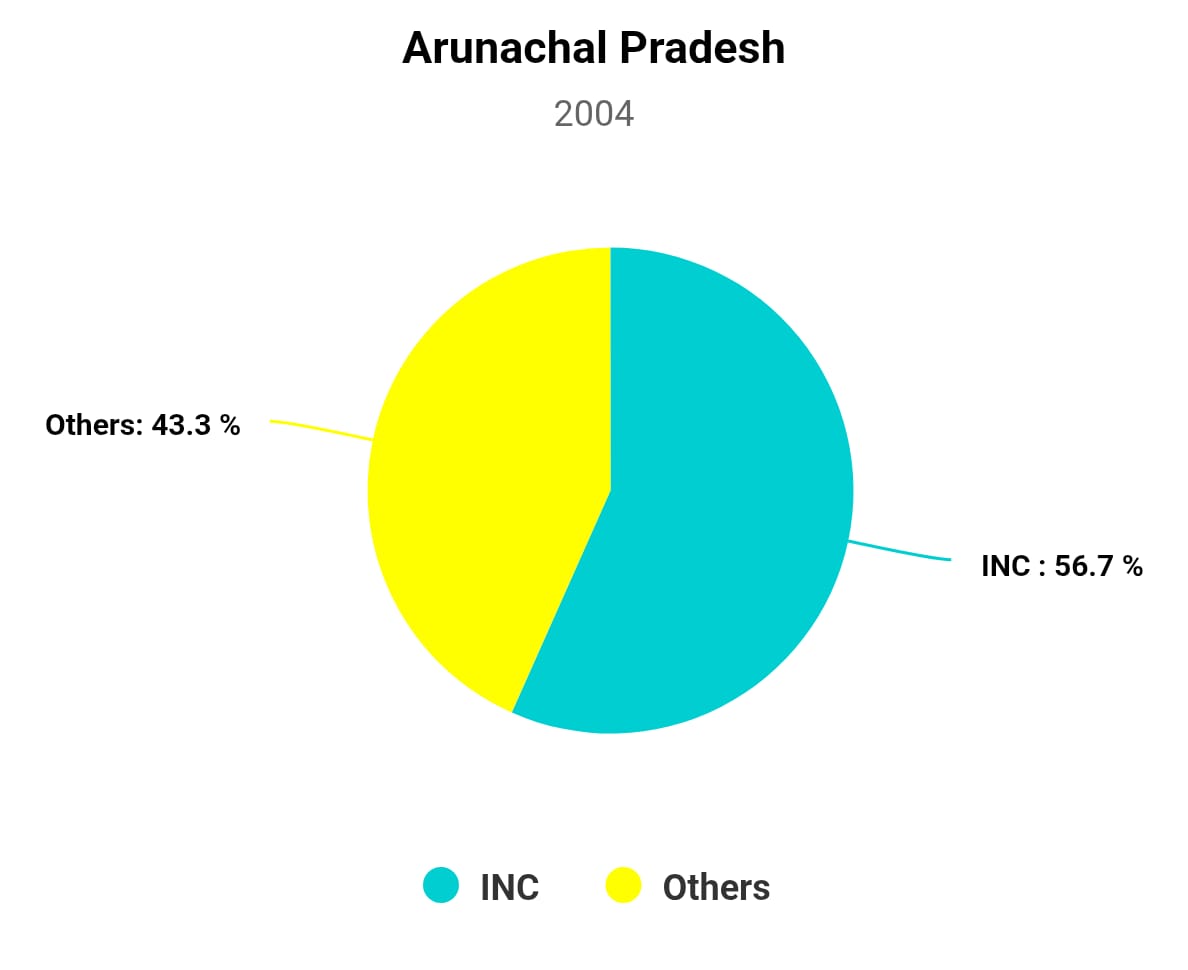
2009 Arunachal Pradesh Legislative Assembly Election
| 2009 Arunachal Pradesh Legislative Assembly Election | |||
|---|---|---|---|
| Sr. No. | Short Name | Full Name | Seats |
| 1 | INC | Indian National Congress | 42 |
| 2 | NCP | Nationalist Congress Party | 5 |
| 3 | Independents & Others | Independents & Others | 13 |
| Total | 60 | ||
The 2009 assembly election reinforced the INC's dominance in Arunachal Pradesh’s politics, with Dorjee Khandu continuing as Chief Minister. Although national and regional parties gained some ground, the opposition remained fragmented—bolstering INC’s position.
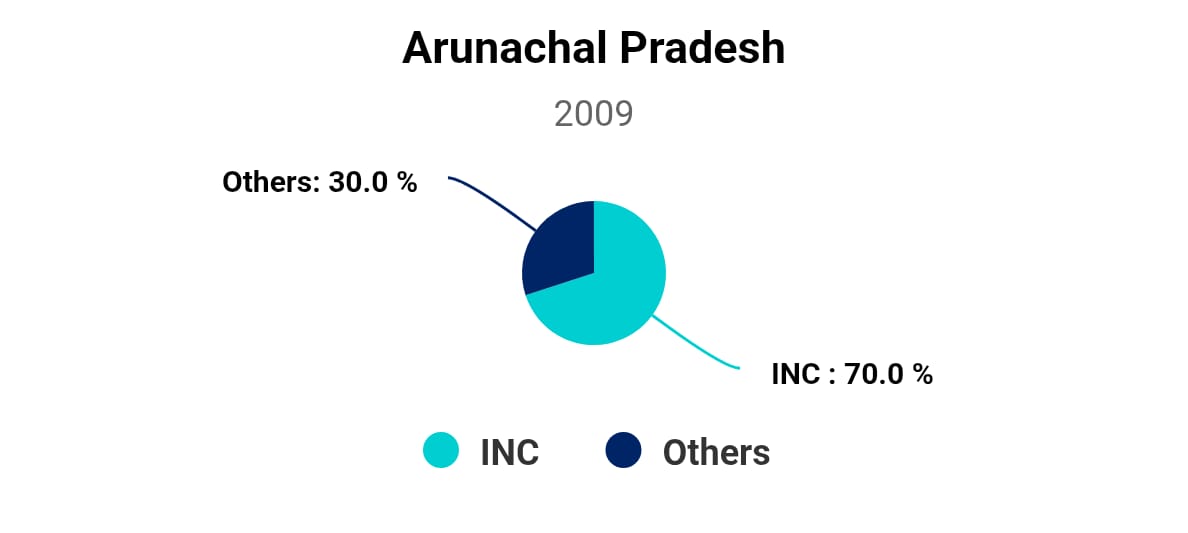
2014 Arunachal Pradesh Legislative Assembly Election
| 2014 Arunachal Pradesh Legislative Assembly Election | |||
|---|---|---|---|
| Sr. No. | Short Name | Full Name | Seats |
| 1 | INC | Indian National Congress | 42 |
| 2 | BJP | Bharatiya Janata Party | 11 |
| 3 | Independents & Others | Independents & Others | 7 |
| Total | 60 | ||
Stable INC Rule: The Indian National Congress maintained its majority with 42 seats, securing continuity in governance under Nabam Tuki.
BJP Resurgence: The BJP improved significantly, from 3 seats in 2009 to 11 in 2014.
Minor Players: PPA continued to hold a presence with 5 seats, while smaller parties had no elected MLAs.
High Turnout: With over 80% voter participation, the election reflected strong democratic engagement in the state.
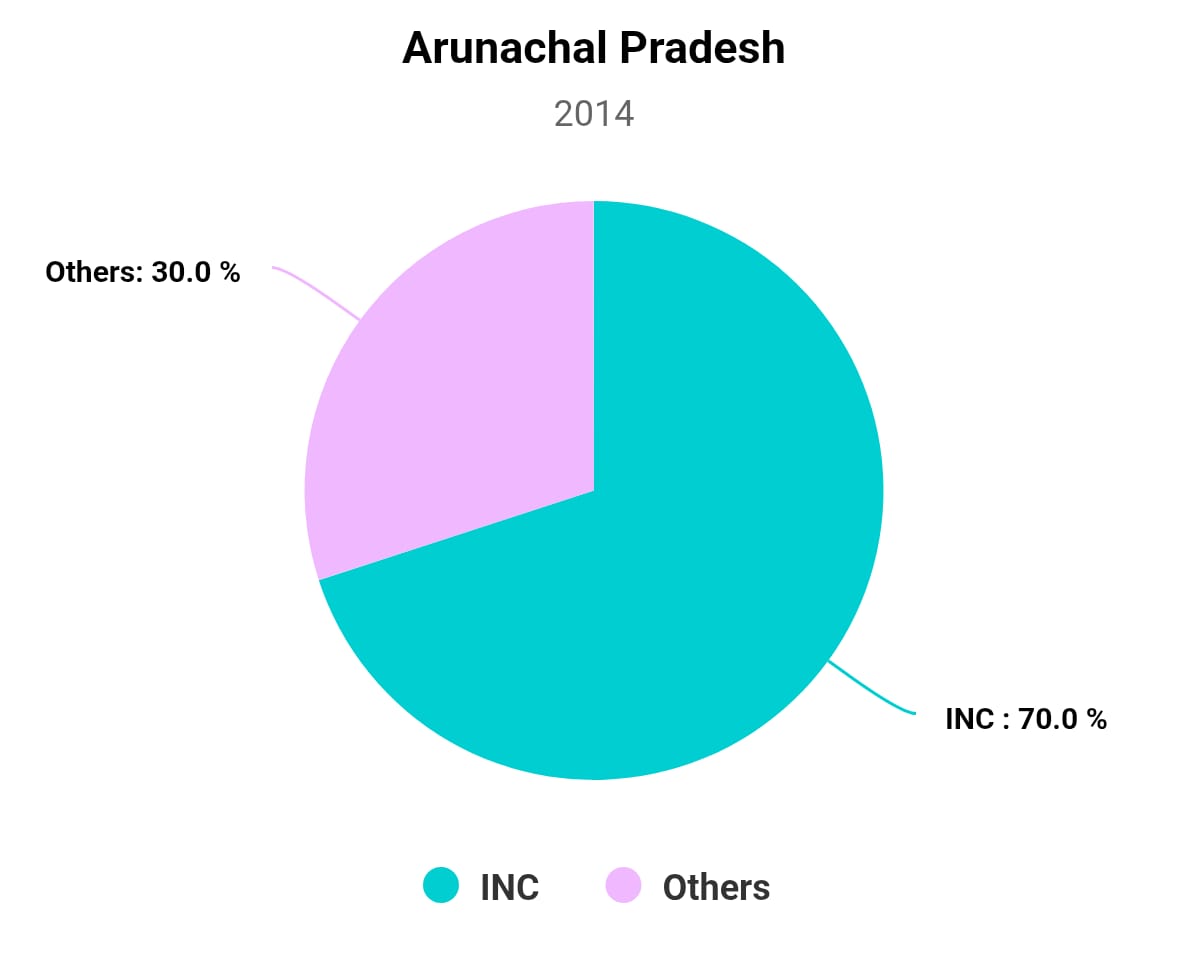
2019 Arunachal Pradesh Legislative Assembly Election Results
| 2019 Arunachal Pradesh Legislative Assembly Election Results | |||
|---|---|---|---|
| Sr. No. | Short Name | Full Name | Seats |
| 1 | BJP | Bharatiya Janata Party | 41 |
| 2 | JD(U) | Janta Dal (United) | 7 |
| 3 | INC | Indian National Congress | 4 |
| 4 | Independents & Others | Independents & Others | 8 |
| Total | 60 | ||
BJP led the assembly with a comfortable majority, securing 41 of 60 seats—well above the required 31-seat majority.
INC's performance was weak, with only 4 seats and a vote share significantly lower than BJP’s.
JD(U) and NPP emerged as stronger players, winning 7 and 5 seats respectively, marking significant gains .
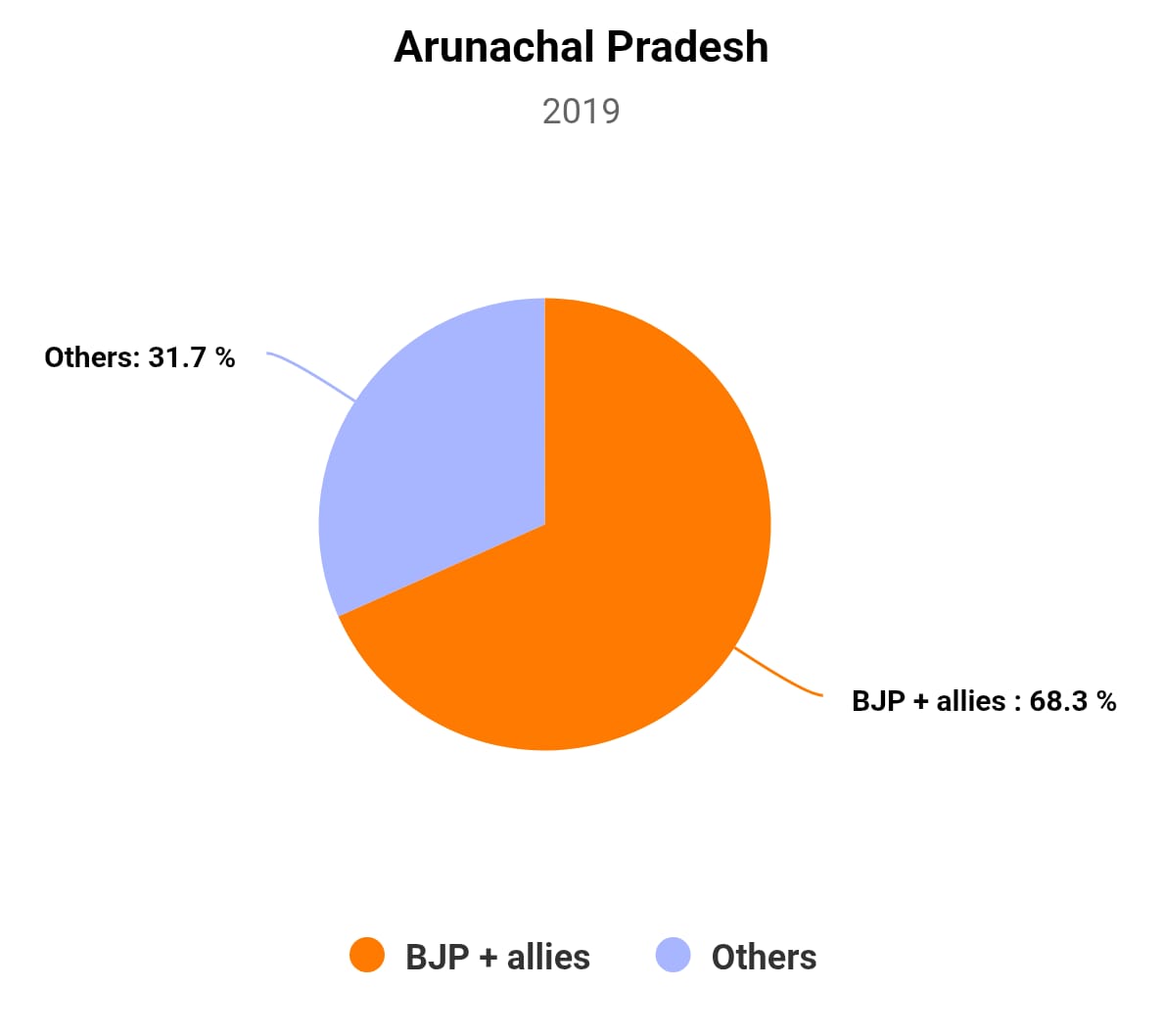
2024 Arunachal Pradesh Legislative Assembly Election Results
| 2024 Arunachal Pradesh Legislative Assembly Election Results | |||
|---|---|---|---|
| Sr. No. | Short Name | Full Name | Seats |
| 1 | BJP | Bharatiya Janata Party | 46 |
| 2 | Independents & Others | Independents & Others | 14 |
| Total | 60 | ||
BJP Dominates Again: With 46 seats, BJP achieved a commanding victory, reinforcing its dominance in the state.
Weak Opposition: Congress was nearly wiped out with just one seat.
Regional Parties Gain Ground: Both NPP and PPA maintained presence with 5 and 2 seats respectively.
Strategic Realignment: The 2025 defections from NPP to PPA may further bolster the BJP-led coalition.
